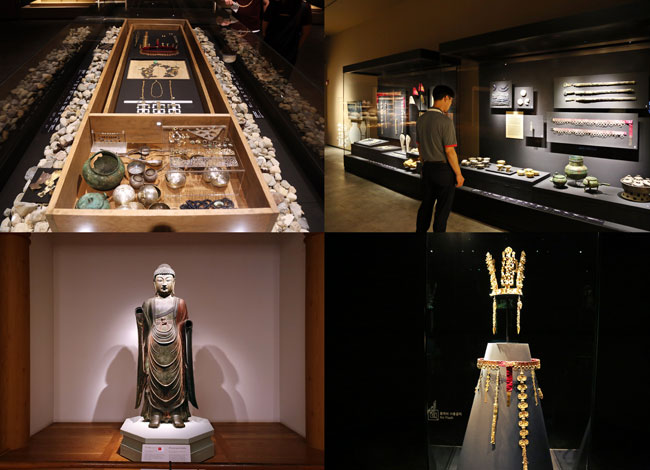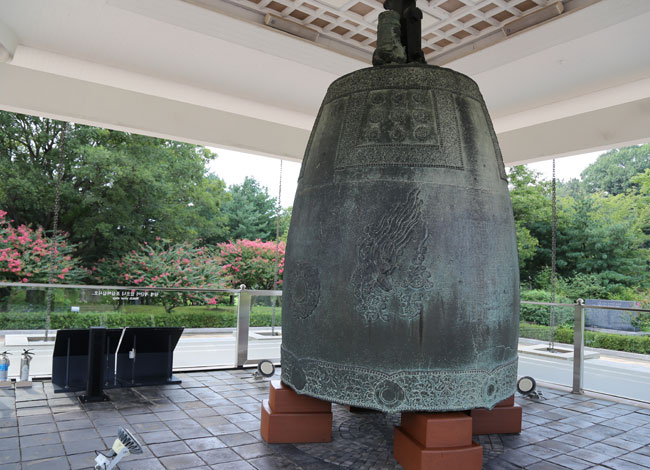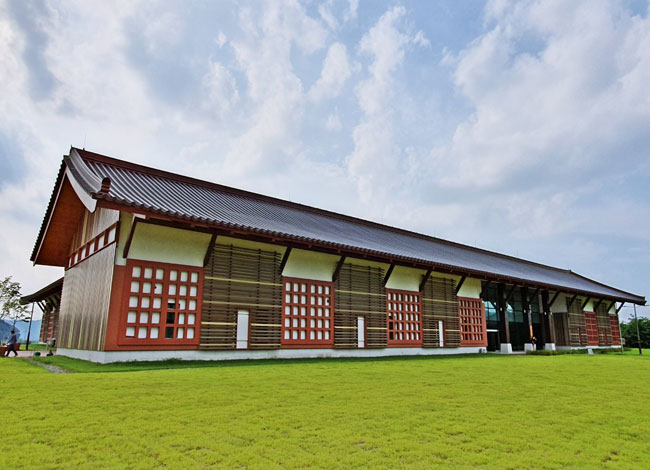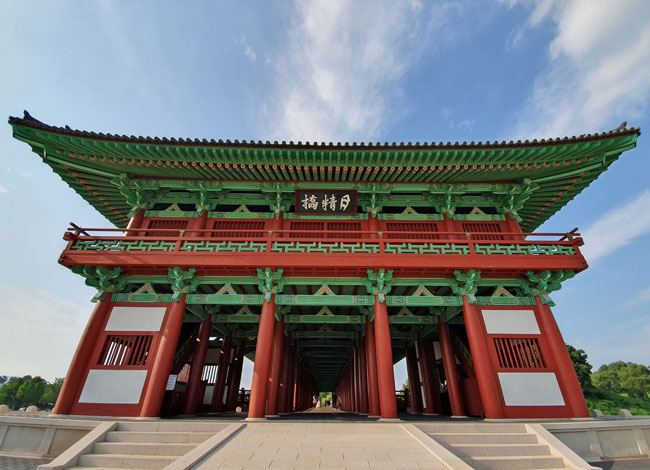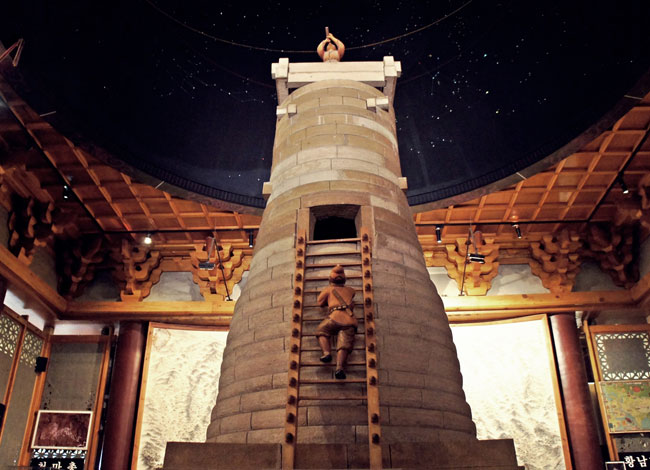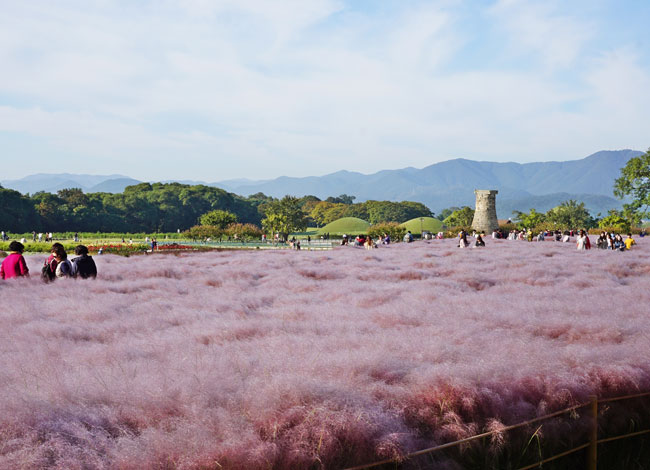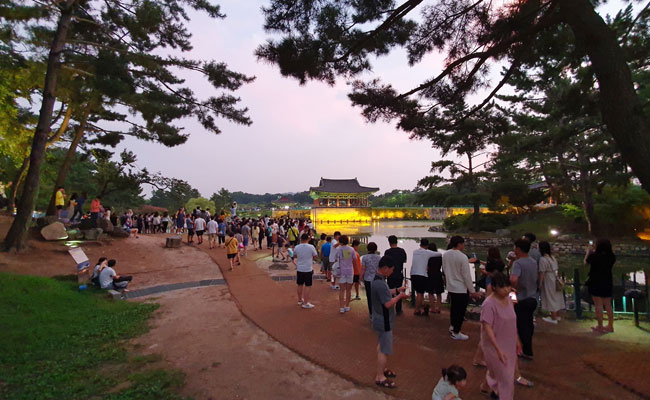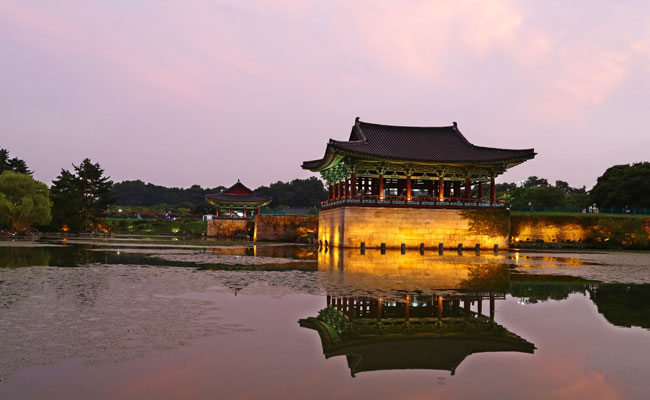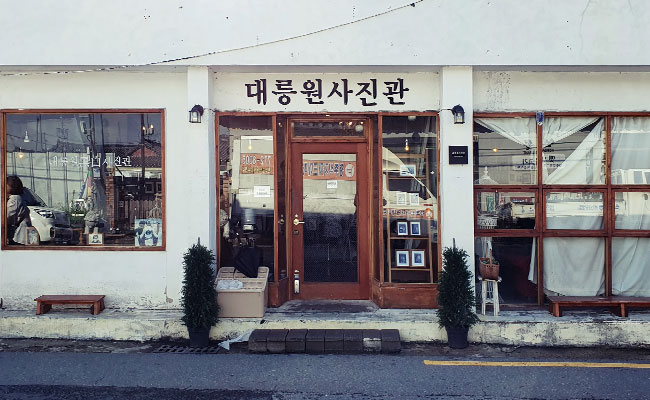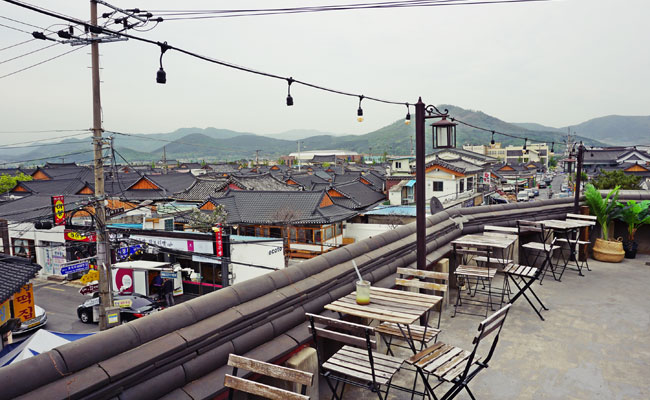Gyeongju Travel
The Gyeongju Downtown Bible
한국관광의 메카 “Beautiful Gyeongju”가 여러분을 초대합니다.
- Stimulate your Imagination in the Heart of the Silla Dynasty
- It comes as no surprise that the hot place from a 1,000 years ago remains a hot place to this day. The key to any tour of downtown Gyeongju comes down to Gyeongju’s Historic sites. Here, you can explore Wolseong, which served as the royal palace of Silla, Donggung and Wolji, which served as the main living quarters for princes, Daereungwon, a spot for the leisure and recreation of kings, Cheomseongdae, the oldest astronomical observatory in Asia, and Gyelim, Silla’s sacred forest.
-
Travel Course Explanation
#MainDowntownCourse #RelaxingCourse #DowntownWalkingTour #DowntownBikingTour
This course is recommended for those taking either a day trip, or an overnight trip. All attractions are located within a 3-kilometer radius. It’s great for travelers looking to explore the city on foot at their own pace, or those looking to do a cycling tour. If you feel the urge to see more of Gyeongju, you can always add Bulguksa Temple or Bomun Tourist Complex to your Gyeongju Downtown Travel Bible itinerary. -
Recommended Course
- One Day Course
- 1Gyeongju National Museum 2Woljeonggyo Bridge 3Cheomseongdae 4Daereungwon 5Donggung and Wolji
- Two Day Course
- 1Wolseong Excavation Site 2Hwangridan-gil
#1‘Summary of Silla’ National Gyeongju Museum
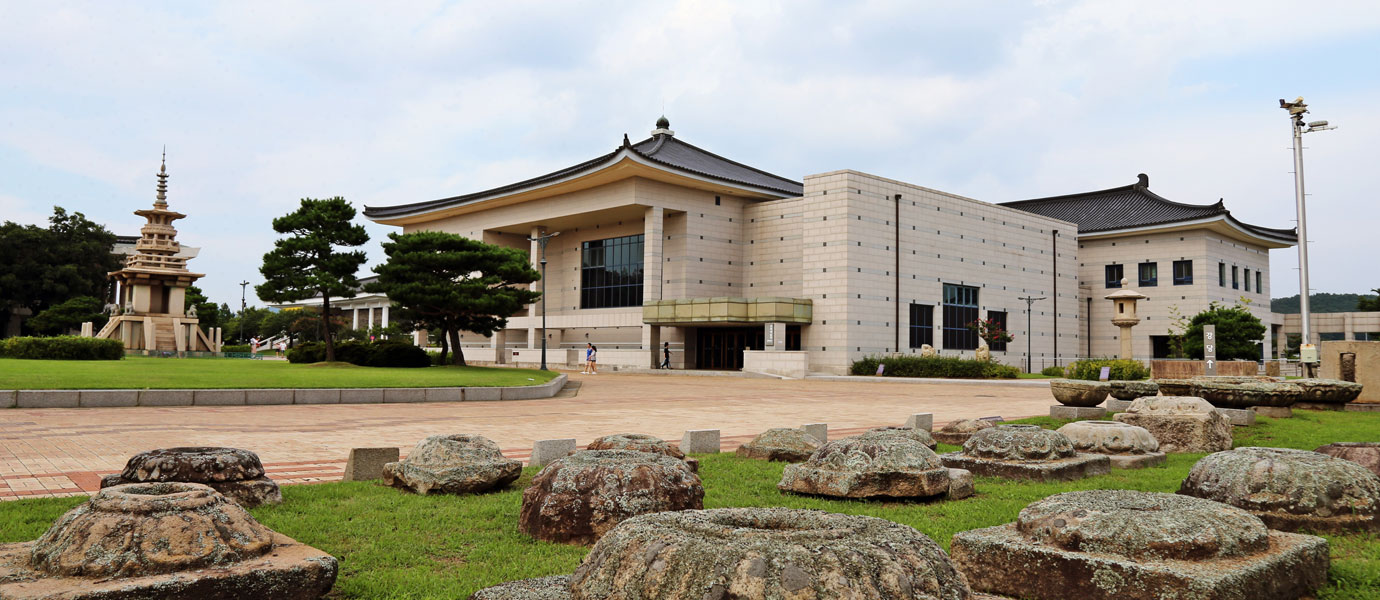
Before you start your trip across Gyeongju, there’s a perfect place where you can catch up on the history and culture of the city. You can learn about Silla’s cultural heritage at the Gyeongju National Museum. It’s hard to believe that the brilliant Golden Crown of Silla so often seen in textbooks remained buried for a thousand years. See it with your own eyes! Some say the Golden Crown alone is reason enough to visit the Gyeongju National Museum. Of course, if you look around the Gyeongju National Museum, you’ll find so many more interesting things. Before you know it, you might end up spending half a day at the Museum admiring the treasures of Silla.
Apart from the main Silla History Hall, the Gyeongju National Museum also has the Silla Art Hall, Wolji Hall, and a Special Exhibition Hall. Silla History Hall features four rooms covering the rise and fall Silla. Of course, when talking about Silla culture, Buddhist art is extremely important, and the National Museum has plenty of Buddhism-related content on display in the Silla Art Hall. Meanwhile, Wolji Hall has exhibits related to Donggung and Wolji. Here, you’ll find restored models of Donggung and Wolji as well as precious treasures, including a wooden boat and Gilt-Bronze Buddha Triad Statue, that were excavated at Wolji. In each of the three permanent exhibition halls, there are exhibition commentary programs offered at certain times of the day, so it might be a good idea to check the timetable before your visit if you want to join one of the guided tours.
Don’t miss the Outdoor exhibition as well! Here, visitors can see national treasures such as the magnificent giant Bell of King Seokdoek the Great, which is also known as the Emile Bell, as well as the Goseonsaji 3-story Stone Pagoda. Earlier this year, the newly renovated Children's Museum reopened at Gyeongju National Museum. But don’t let the name fool you. The Children’s Museum is perfect for all visitors regardless of age or gender interested in experiencing Silla’s history. The Children’s Museum features the latest exhibition techniques in five zones with themes such as “Become a Hwarang (an Elite Knight),” “Meet the King,” “Dream of Buddha’s World,” “Widen the World Stage,” and “Silla’s Advanced Art and Science.”
In May 2019, the newly built Yeongnam Area Storage Facility was opened to the public, adding to the list of attractions at the Gyeongju National Museum. This storage facility was built to systematically store approximately 600,000 pieces of cultural artifacts discovered in the Yeongnam region. In particular, the Exhibition Storage Hall showcases more than 3,000 artifacts from Silla such as earthenware and tiles, and the Lobby Exhibition Hall offers an opportunity for visitors to learn about the process of discovering, preserving, and restoring cultural artifacts.
Gyeongju National Museum Admission Information
- Location : Gyeongbuk, Gyeongju-si, Yeong-ro 186
- Opening Hours
관람시간을 요일, 기간, 시간(개관, 폐관) 순으로 나타낸 표입니다. Day Period Times Hall Opens Hall Closes Weekdays
Mon-FriAll Year 10.00 18.00 Culture Day
(Last Wednesday of every month)10.00 21.00 Saturday January & February 10.00 19.00 March to December 10.00 21.00 Sunday & Public Holidays All Year 10.00 19.00 - Closed : January 1st, Lunar New Year, Chuseok
- Entrance Fee : Free
- Inquiries: 054 740 7500
- Website : www.gyeongju.museum.go.kr
#2Woljeonggyo Bridge, a picturesque feat of engineering on the Namcheon Stream
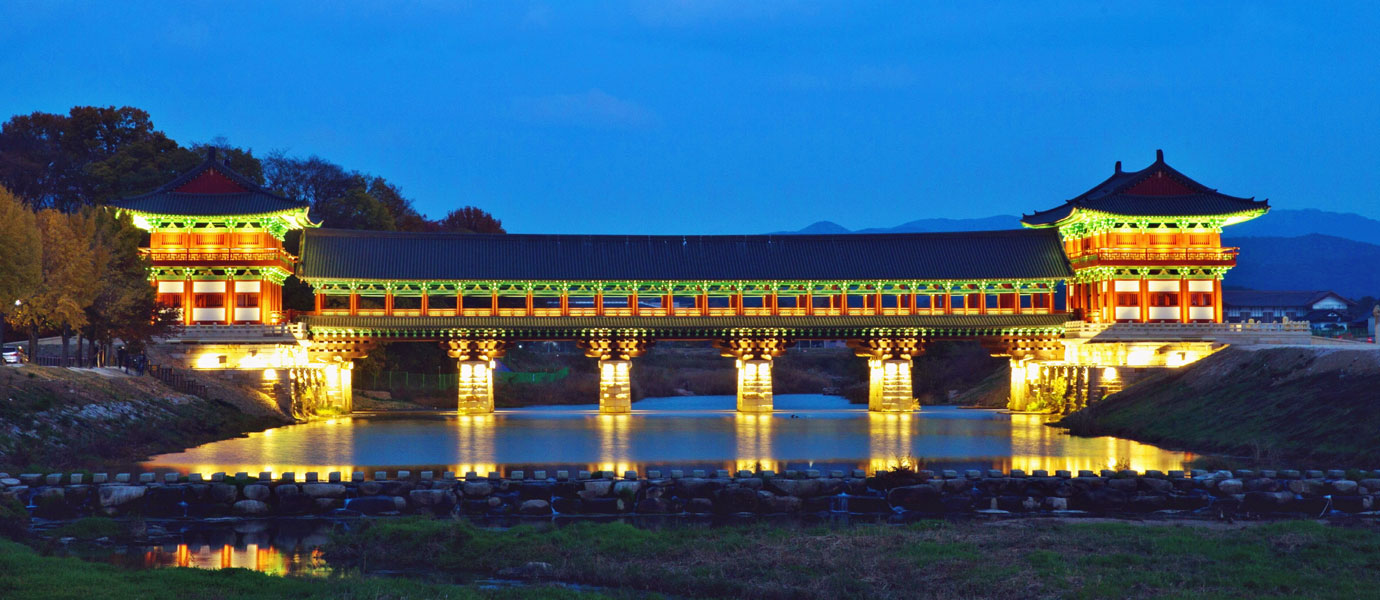
Woljeonggyo Bridge is a picturesque bridge built over the Namcheon Stream (Muncheon Stream). During Silla, it served as a passage to Wolseong in the south. Woljeonggyo Bridge became particularly famous because it served as the backdrop of a love affair between a Buddhist monk named Wonhyo and Princes Yoseok. Records of the name Woljeonggyo Bridge was first discovered in a passage written by Kim Bu-Sik in his book Samguk Sagi (History of the Three Kingdoms) from the 19th year of King Gyeongdeok’s reign (Unified Silla). He stated that, “On the Muncheon stream, there are two bridges, the Woljeonggyo Bridge and the Chunyanggyo bridge.”
Since the bridge was lost during the Joseon Dynasty, modern archaeologists spent more than ten years to find and verify the location of the bridge, and to fully restore its features (restoration completed in April 2018). The actual construction of the bridge was completed in 2013, but further work was required to complete the gatehouses (Munlo門樓) on both ends of the bridge. On the second floor of the gatehouse, visitors can enjoy a video documentary about the reconstruction and view the various exhibited artifacts that were excavated on site. Woljeonggyo Bridge looks beautiful in the day, but it looks even more stunning at night. You’ll feel yourself welling up with emotions when you see the soft lights illuminating the bridge, the stream flowing underneath, and the moon shining in the sky.
Woljeonggyo Bridge Information
- Location : 274, Gyo-dong, Gyeongju, Gyeongbuk
- Woljeonggyo Bridge Opening Hours : 09:00 – 22:00
- Gatehouse Hours : 10 – 22:00
- Entrance Fee : Free
#3Cheomseongdae, the Remaining Witness of Silla’s History
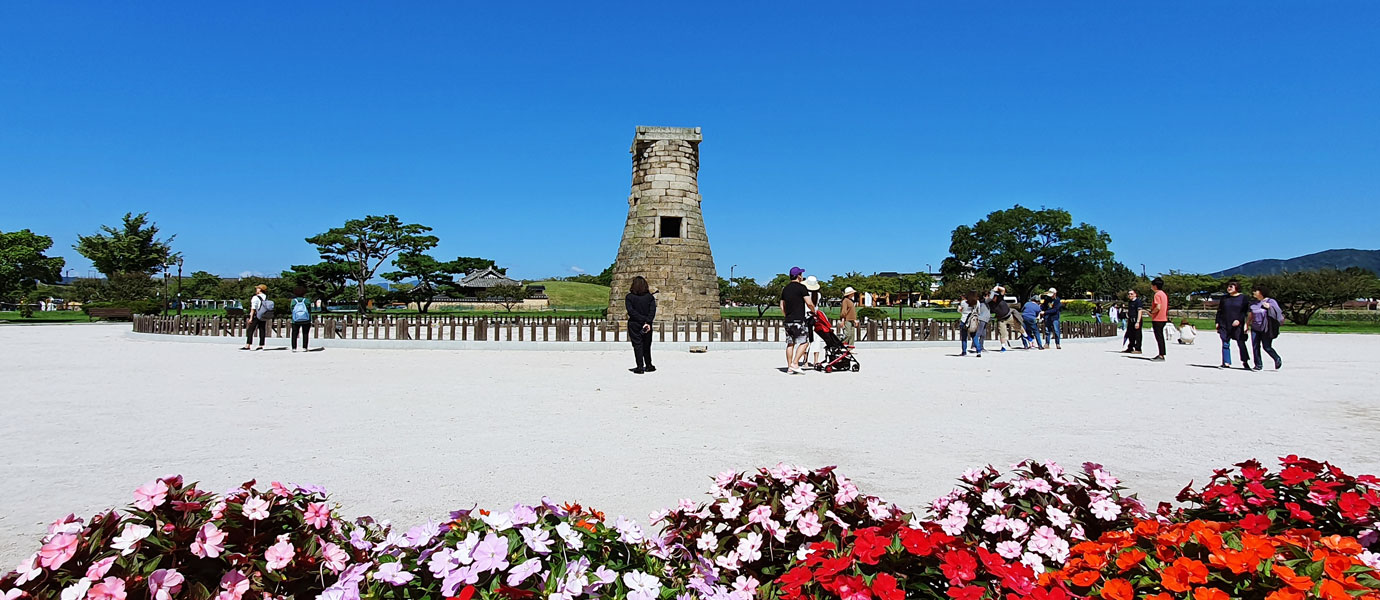
Sitting in one place for more than a millennia is an impressive feat. Chaomeseongdae, a heritage so often seen in textbooks, has stood in the same spot for 1,500 years right in the heart of Silla’s history. This unmistakable landmark of Gyeongju has such a unique design that there is hardly anyone who hasn’t bought a souvenir of it. Its unique shape inspired countless scholars to research Cheomseongdae, and there have been many theories about its use. Some say Cheomseongdae was used for heavenly rituals, others say it was simply a symbolic tower. But the most dominant theory is that Cheomseongdae was an astronomical observatory.
This scientific stone building is the “oldest astronomical observatory in Asia”. The 365 stones from which Cheomseongdae is comprised signify the number of days in a year, and the total of 29 levels or 30 levels of stone steps of the stone pavilion (depending on the platforms you count from) represent the days in a lunar month. Meanwhile, the top 12 columns and the bottom 12 columns of the window symbolize the 24 seasonal divisions of the year according to the lunar calendar. These are amazing scientific features and evidence all pointing towards Cheomseongdae being a place to observe the movements in the sky. Counting the stones in front of Cheomseongdae is a great way to check what you have seen in books.
Cheomseongdae Information
- Location : 839-1, Inwang-dong, Gyeongju, Gyeongbuk
- Opening hours : 09:00-22:00 (until 21:00 in winter), Open all year
- Entrance Fee : Free
#4Daereungwon, The Park of Royal Tombs
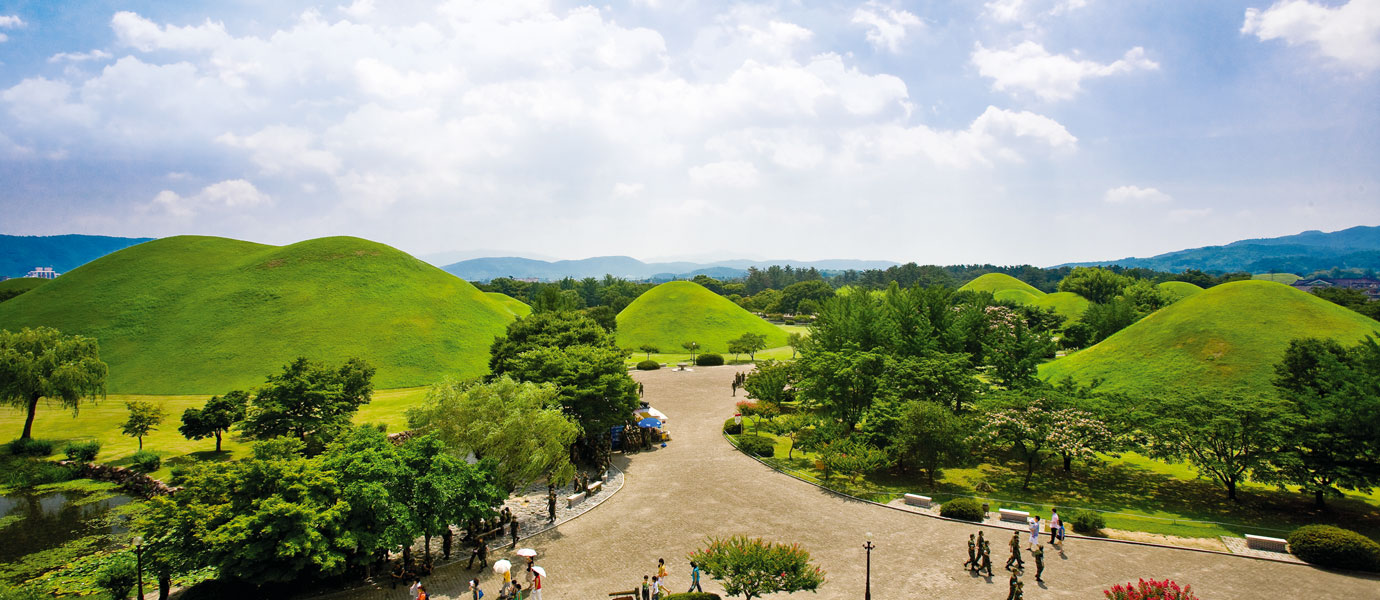
Travelers visiting Daereungdong have their own reasons for coming. There are those who want to go straight to see the inside of the tomb at Cheonmachong (Tomb of the Heavenly Horse), there are those who want to see the Great Hwangnam Tomb, which is the biggest in Gyeongju, there are those who wonder “what’s that?” and go to take a selfie in front of the giant magnolia tree, and then there are those who leisurely walk around to explore the tombs. As it is located across 126,500㎡ of land in Hwangnam-dong, there is more than enough places to explore for everyone at Daereungwon.
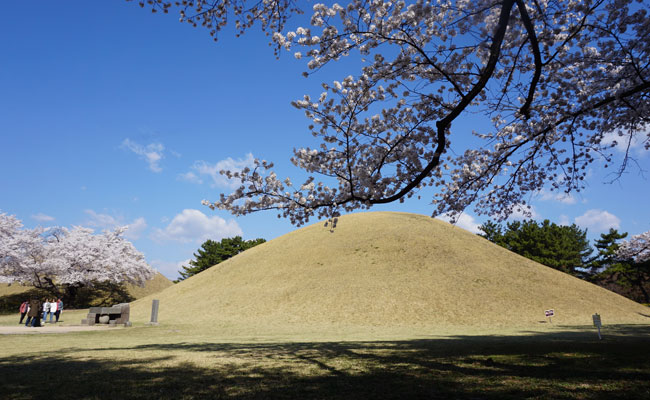
- The Tomb of King Michu
- When the Yiseo Kingdom invaded the Silla Kingdom, Silla soldiers put Bamboo leaves on their heads and drove off the invaders. When King Michu passed, bamboo leaves piled up in front of his tomb. According to legend, this was because of King Michu’s desire to protect the country even after his death. Thereafter, people started calling his grave “the Bamboo Tomb.” Beautiful cherry trees surround the Tomb of King Michu as if standing guard for the fallen king, which is why the Tomb is famous for its cherry blossoms in spring.
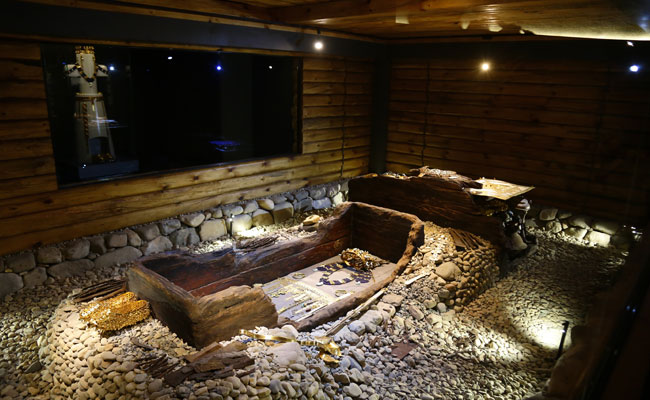
- Chenmachong (Tomb of the Heavenly Horse)
- Cheonmachong is so famous that instead of calling the area Daereungwon, the people of Gyeongju often call it Cheonmachong. In 1973, in order to practice for the excavation of the Great Hwangnam Tomb, an adjacent tomb was chosen as a testing ground. To the surprise of researchers, they discovered many valuable artifacts, including a mural of the Heavenly horses of the Jade Emperor coming to earth. Since then, tomb no. 155 came to be known as the Cheonmachong (Tomb of the Heavenly Horse), and one of the few royal tombs from Silla which the interior can be viewed.
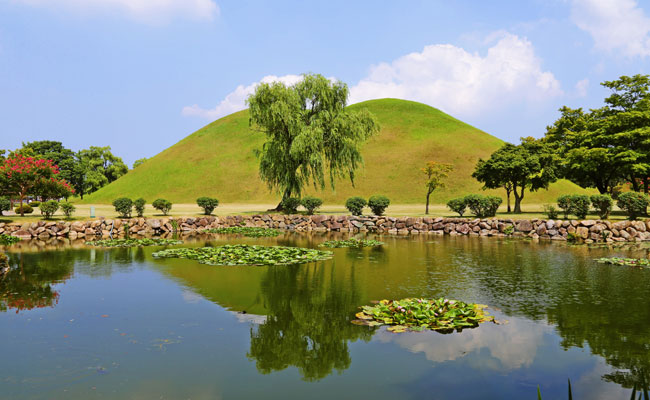
- The Great Hwangnam Tomb
- Encouraged by their findings in Cheonmachong, researchers began excavation of tomb no. 98, the biggest tomb in Gyeongju. It was a major excavation involving more than 30,000 people over two years. The Great Hwangnam Tomb is a twin tomb with mounds resembling the two humps of a Bactrian camel. As expected from such a massive complex, approximately 57,000 artifacts were found in the north and south mounds. It is considered the grave of a royal couple due to the artifacts found there. The northern mound contained a gold crown and woman’s accessories such as a belt, necklace, bracelet, etc. Meanwhile, the southern mound contained male bone remains, a gilt-bronze crown and weaponry.
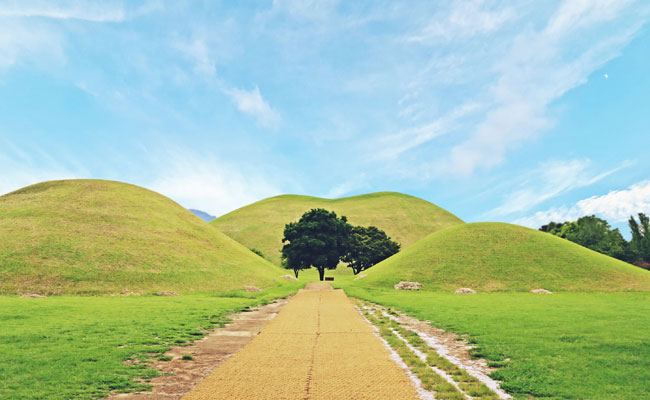
- Daereungwon Photo-Zone
- If you’re visiting Daereungwon these days, there’s another place you can’t miss. Behind the Great Hangnam Tomb, there is a beautiful magnolia tree which has become a popular selfie spot. Quite often you’ll see people lining up in front of the tree to take a photo.
Daereungwon Information
- Location : Hwangnam-dong, Gyeongju, Gyeongbuk
- Opening Hours : 09: 22-20: 00 (Closed at 21:30), Open all year
- Admission Fee : Adults 3,000 won / Youth 2,000 won / Children 1,000 won
- Gyeongju Historic Site Online Ticketing System : http://gjpass.kr/
#5Donggung and Wolji with fifty thousand evening colors
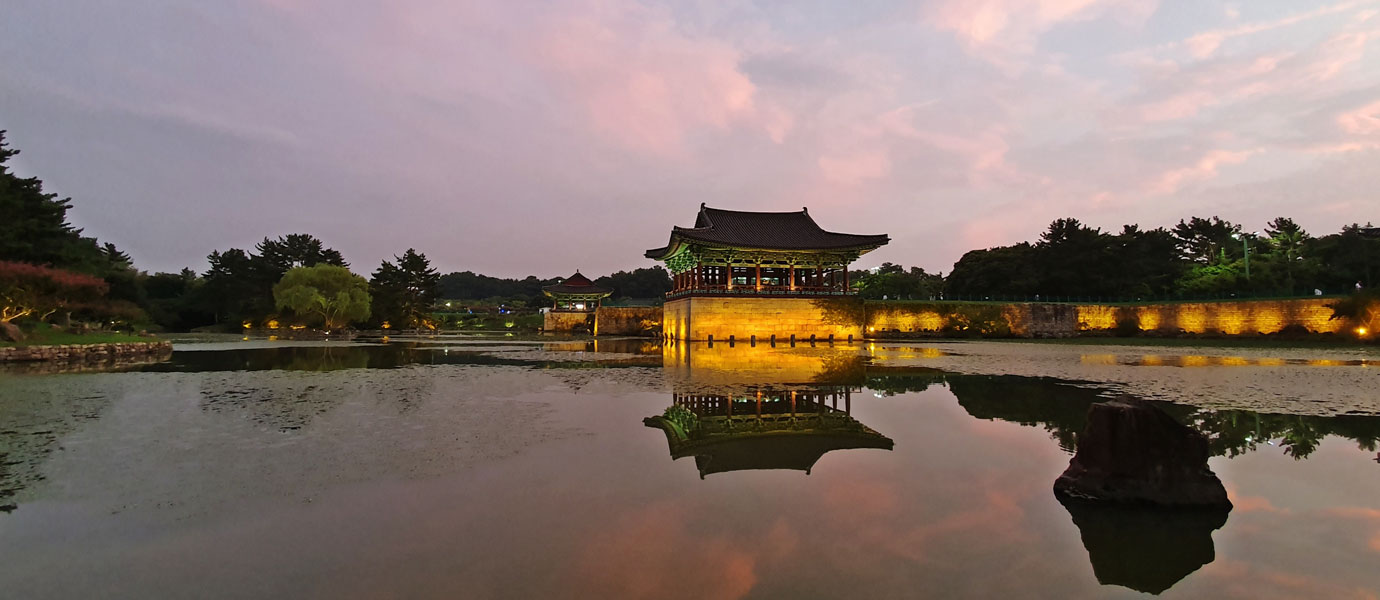
The best time to see Donggung and Wolji is in the evening, more specifically during what is called the “magic hour” where the setting sun bathes the restored buildings in soft light, making the already gorgeous scenery even more beautiful. When watching the sunset loses its luster, the lights come on all around Donggung and Wolji. Every minute and every second, the hues slightly change, making the entire compound look like a kaleidoscope of 50,000 colors ranging from pale orange to crimson, and a mysterious purple fading into the color of the night.
Some might be more familiar with the name “Anapji.” This no. 1 tourist hot spot in Gyeongju during the evening used to be known as Anapji. Originally a palace for princes, Donggung and Wolji came to be known as Anapji when it fell into ruin during the Joseon Dynasty and became a haven for wild geese and ducks. After finding the original name in the Samguk Sagi (History of the Three Kingdoms), Anapji was renamed Donggung and Wolji. In the 14th year of King Munmu (674 CE) he created the pond called “Wolji” and after the unification of Silla, the palace “Donggung” was constructed in 679 CE.
The Imhaejeon Hall was used by princes for banquets, meetings, and entertainment inside the Donggung palace. Wolji, which is 200m-long east to west and 180m-long north to south, has a straight shoreline around the southwest, and a meandering shoreline to the northeast. Due to this shape, it is not possible to capture the whole pond with a single photo. This makes Wolji feel like an ocean where you can’t find the place where the water ends. The Chinese characters for the name Imhaejeon (臨海殿) mean “a royal palace overlooking the sea,” which refers to the ocean-like pond of Wolji.
Donggung and Wolji Information
- Location : 102 Wonhwa-ro, Gyeongju, Gyeongbuk
- Opening Hours : 09: 22-20: 00 (Closed at 21:30), Open all year
- Entrance Fee : Adults 3,000 won / Teenagers 2,000 won / Children 1,000 won
- Gyeongju Historic Site Online Ticketing System : http://gjpass.kr/
#6Wolseong Excavation Site, Sparking the Imagination
In December of 2014, an opening ceremony was held and archaeologists began excavation work to unearth the Silla Imperial Palace buried deep in the ground. The government-funded Silla Royal District Restoration Project aims to restore the palaces of the kings and recover the thousand-year history of Silla. Take a look at the ongoing excavations from the observation deck and see with your minds eye where the royal palace stood or build government offices with your imagination. The moat protecting the castle walls and the interior of the castle have been divided into four zones (Zones A-D) with numerous artifacts recovered.
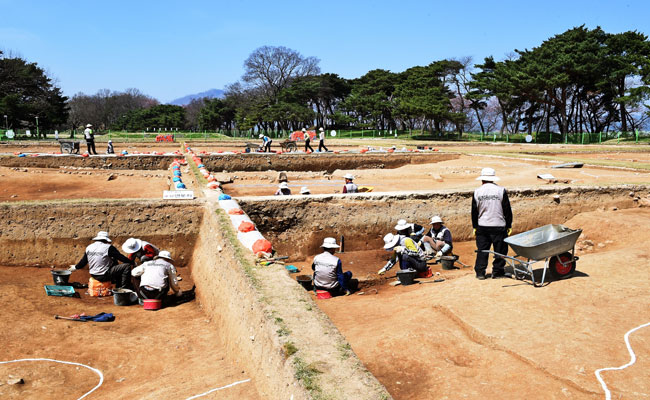
- Wolseong Excavation Site
- A total of 17 buildings from the late-Unified Silla were found in Zone C (Zone containing palace and main buildings) surrounded by a square wall. A variety of artifacts were excavated including woodcuts (wooden tablets used for writing records) containing records of official performances, rice roots, various pieces of earthenware, clay dolls, animal bones, and plant seeds. Among the relics excavated from the wall are the two human bones, many inkstones, and a very unique clay doll wearing a turban.
While surveying the western wall of Wolseong, two human bones were found. Finding these bones sparked much interest because it suggested that people had been offered as sacrifices to prevent the wall from falling. The many inkstones excavated from the central building are important clues to prove that that the buildings were government offices, while the clay doll wearing a turban suggests that Silla was a Kingdom with connections to kingdoms in the ancient western world.
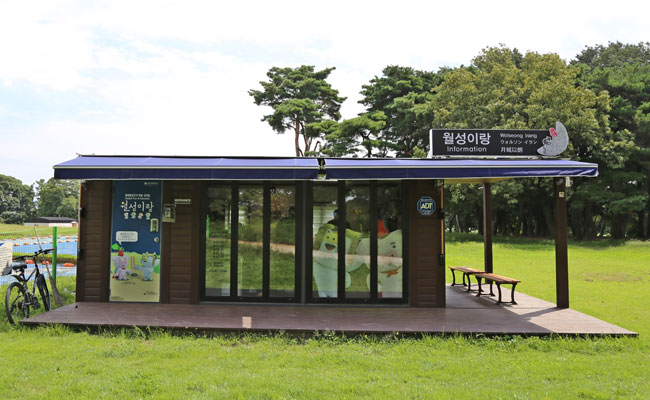
- Wolseong Excavation Site Establishment Guided Tour Program “With Wolseong”
- If you want to learn more about the Wolseong Excavation Site, join the Wolseong excavation site guided tour program “With Wolseong.” The name “With Wolseong” was chosen by the Wolseong Excavation Site to help bring the community together and make them feel part of the Silla Royal District Restoration Project.
The “With Wolseong” excavation site guided tour program will explain the excavation process, the results achieved so far, and the unearthed artifacts. There are five tours per day and each tour lasts about 30 minutes. Tours can be booked onsite at the Education Office. There is also an event that opens up the inside of Wolseong Excavation site to the public at 2:00 pm every Friday during the summer season.
“With Wolseong” Tour Information
- Guided Tour Program: 5 times a day, at 10:00, 11:00, 13:30, 15:00, 16:30, each session lasts 30 minutes
- Guided Tour Booking
- On-site application (at Education office in Wolseong Excavation Site)
- Advanced Booking (Group-oriented, Phone: 054-777-5027 / e-mail : ws_irang@naver.com)
- Commentary operation may be adjusted depending on the time of day, weather, etc so please inquire before visiting.
- Revealing of excavated artefacts every Friday at 2 pm in Summer
#7Hwangridan-gil: The Heart of Silla, the Heart of Gyeongju Travel
In recent years, the quiet Hanok houses near Daereungwon have been transformed into Hanok hotels and brunch cafés. The real name of this place is Poseok Road, but it came to be called Hwangridan-gil after people gave the road a nickname inspired by the pattern of the Gyeongnidan-gil in Itaewon, Seoul.
Hwangridan-gil is the newest, hottest road in Gyeongju. Two or three years ago, it became a place for young people to hang out, and has since seen more cafés, charming little stores, souvenir shops, and personality-filled restaurants move into the area. Wherever you look, you’ll see new stores. But it’s not just Poseok road (Hwangridan-gil) that has benefited from this sudden rise in popularity. The entire Hwangnam area, the backstreets of Sajeong area and Doldamstreet to the west of Daeneungwon are also enjoying more activity and a livelier ambiance thanks to the popularity of Hwangridan-gil.
Hwangridan-gil Information
- Location: Gyeongju, Hwangnam-dong, Sajeong-dong
- How to find: Searching for Daereungwon Gate or Naenam Intersection 5-10 minutes walk from Express / Intercity Bus Terminal
